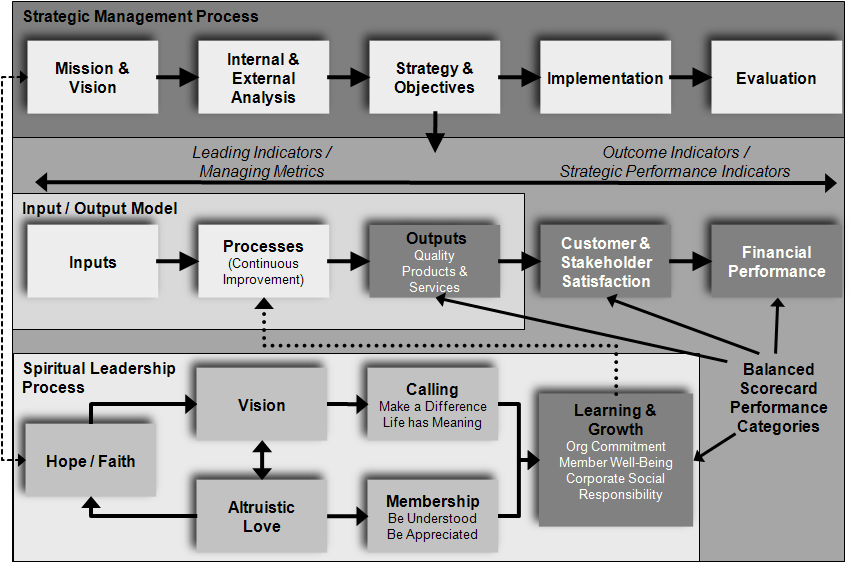Organizations that focus on sustainability and strategic performance measurement have been at the forefront of the movement to maximize the Triple Bottom Line. They stress the need for a new business model that emphasizes nonfinancial predictors of financial performance such as leadership, operating/internal measures, quality, customer satisfaction, employee well-being, and social responsibility. Measuring organizational performance in this new way requires the adoption of a stakeholder approach. Organizations need to embrace the various internal and external parties that have a legitimate strategic and moral stake in the organizations performance. These stakeholders have different values, interests, and expectations as well as different relationships with other individuals, groups and organizations. The main purpose of the stakeholder approach is to define the common good of the organization, while meeting the needs and safeguarding the rights of the various stakeholders. By achieving congruence between customer, worker, and other stakeholder values and expectations, leaders will enhance, rather than detract from, corporate profitability.
The Spiritual Leadership Balanced Scorecard Business Model
The Spiritual Leadership Balanced Scorecard Business Model given in Figure 1 draws from the latest developments of the Baldrige and Balanced Scorecard approaches to performance excellence. It emphasizes stakeholder satisfaction and the spiritual leadership model as key to maximizing the Triple Bottom Line. Strategic leaders — through choices about vision, purpose, mission, strategy, and their implementation — are responsible for creating vision and value congruence across all organizational levels. In the upper third of Figure 1, the strategic management process is shown beginning with the development of a vision, purpose, and mission, followed by an internal and external analysis, which results in strategic action plans and objectives. These objectives form basis for the leading and lagging indicators that are selected for key Balanced Scorecard Performance Categories.
Leading indicators and management metrics are used to measure the performance of ongoing company operations, which are depicted in the figure’s input/output model in the center third of Figure 1. Generally, the more strategic the level of the scorecard in the organizational chart, the more results oriented and lagging are the specific measures that are reported in the scorecard. These measures comprise the quality, customer and stakeholder satisfaction, and financial Balanced Scorecard Performance Categories. For example, the quality of a firm’s products and services are outputs that are leading indicators of customer satisfaction, which in turn, is a leading indicator of financial performance. However, quality is also a lagging indicator of the efficiency and effectiveness of the organizations key production processes.
In the bottom third of the Figure 1, employee learning and growth, which is the central balanced scorecard performance category, is driven by the spiritual leadership process. This is because the learning and growth category is a leading indicator and drives the other performance categories. As shown by the dotted line from the learning and growth category to processes, employees who have a sense of well-being and are committed, productive, and socially responsible will strive to continuously improve organizational processes and produce quality products and services that satisfy customers and other key stakeholders expectations, which ultimately drives financial performance. In turn, the learning and growth outcomes of organizational commitment and productivity, employee well-being and social responsibility are driven by the organizational spiritual leadership process. As shown by the dotted line between the strategic management and spiritual leadership processes, strategic leaders must provide the supportive context for the spiritual leadership model to operate effectively across the individual, team, and organizational levels.
Figure 1: Spiritual Leadership Balanced Scorecard Business Model
Triple Bottom Line Outcomes
The Spiritual Leadership Balanced Scorecard Business Model demonstrates the link from spiritual leadership to financial performance. Relative to organizational performance and profits, the intrinsic motivation process in Spiritual Leadership that is based on vision, altruistic love and hope/faith results in an increase in ones sense of Spiritual Well-Being and ultimately increased:
Member well-being (People). In terms of people or enhancing employee well-being, mainstream medical research during the last 20 years has established the power of spirituality in maintaining health. Individuals in work groups that experience high levels of spiritual leadership and spiritual well-being through calling and membership have higher levels of positive human health, psychological well-being, and life satisfaction. More specifically, they have a higher regard for themselves and their past life, good-quality relationships with others, a sense that life is purposeful and meaningful, the capacity to effectively manage their surrounding world, the ability to follow inner convictions, and a sense of continuing growth and self-realization.
Sustainability and corporate social responsibility (Planet). Attending to the sustainability of our planet requires an ongoing commitment to corporate social responsibility. Organizations based on hope/faith in a vision of service to stakeholders through altruistic love (spiritual leadership) are dedicated to being socially responsible. Corporate social responsibility feeds into and flows from the attainment of goals consistent with need for the organization and its workers to function in society as a whole. When members of an organization have a sense of belonging (membership) and a commitment to a common purpose (calling) through spiritual leadership, the organization as a whole is more successful in meeting or exceeding all stakeholder expectations, including those focused on sustainability and corporate social responsibility.
Profit. The field of performance excellence has signaled the need to go beyond reporting financial metrics, such as profit and sales growth, to include nonfinancial predictors of financial performance such as customer satisfaction, organizational outputs such as quality and delivery, process or internal operating measures, and employee commitment and growth. Of these performance categories, employee commitment is the central and leading indicator of these other performance categories. In other words spiritual leadership positively influences:
- Organizational commitment – People with a sense of calling and membership will become attached, loyal to, and want to stay in organizations that have cultures based on the values of altruistic love, and
- Productivity and continuous improvement – People who have hope/faith in the organization’s vision and who experience calling and membership will “Do what it takes” in pursuit of the vision to continuously improve and be more productive.
Organizational commitment and productivity are then key for producing a high level of quality products and services, which then leads to high levels of customer satisfaction and, ultimately, financial performance – the triple bottom line.

